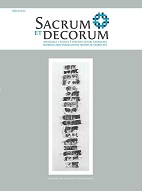Wątki religijne w twórczości Zofii Stryjeńskiej „księżniczki malarstwa polskiego”
Religious motifs in the artwork of ZofiaStryjeńska, „the princess of Polish painting”
Author(s): Lechosław LameńskiSubject(s): Cultural history
Published by: Wydawnictwo Uniwersytetu Rzeszowskiego
Keywords: Zofia Stryjeńska; illustrator; scandalmonger; religious motifs; cycles; Passover; the Sacraments
Summary/Abstract: Zofia Stryjeńska (1891–1976) is one of the most popular and at the same time most scandalous Polish artists of the interwar period. She is commonly known as an outstanding illustrator, although she successfully expressed herself among others in easel and monumental painting. The artist’s compositions impressed viewers with their ever-present movement and dynamics, vivid colours and well-defined figures of people and animals that were clearly related thematically to Polish folklore, its traditions and rites and also to the Piast past. But in this apparently completely secular creation, religious compositions occupied an important place. Between 1917 and 1918 the artist painted in gouache and water-colour five paintings forming the cycle Passover, frequently exhibited both in Poland and abroad.In 1922 the artist completed another cycle, The Sacraments,this time consisting of seven compositions in gouache. Passover and The Sacraments cycles were undoubtedly something extraordinary in the rich and diverse artistic output of ZofiaStryjeńska since 1939. The artist reserved religious motifs only for important and exceptional compositions. After 1946, when the artist chose to emigrate and her financial situation became very bad, she began to paint for sale pictures depicting St Mary, Christ, saints and scenes from the Old and New Testament. Unfortunately they did not have the same expression as the compositions from Passover and The Sacraments cycles.
Journal: Sacrum et Decorum. Materiały i studia z historii sztuki sakralnej
- Issue Year: 2013
- Issue No: 6
- Page Range: 43-61
- Page Count: 19

